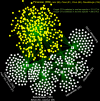Determinants of Deadwood-Inhabiting Fungal Communities in Temperate Forests: Molecular Evidence From a Large Scale Deadwood Decomposition Experiment
- PMID: 30294306
- PMCID: PMC6158579
- DOI: 10.3389/fmicb.2018.02120
Determinants of Deadwood-Inhabiting Fungal Communities in Temperate Forests: Molecular Evidence From a Large Scale Deadwood Decomposition Experiment
Abstract
Despite the important role of wood-inhabiting fungi (WIF) in deadwood decomposition, our knowledge of the factors shaping the dynamics of their species richness and community composition is scarce. This is due to limitations regarding the resolution of classical methods used for characterizing WIF communities and to a lack of well-replicated long-term experiments with sufficient numbers of tree species. Here, we used a large scale experiment with logs of 11 tree species at an early stage of decomposition, distributed across three regions of Germany, to identify the factors shaping WIF community composition and Operational Taxonomic Unit (OTU) richness using next generation sequencing. We found that tree species identity was the most significant factor, corresponding to (P < 0.001) and explaining 10% (representing 48% of the explainable variance) of the overall WIF community composition. The next important group of variables were wood-physicochemical properties, of which wood pH was the only factor that consistently corresponded to WIF community composition. For overall WIF richness patterns, we found that approximately 20% of the total variance was explained by wood N content, location, tree species identity and wood density. It is noteworthy that the importance of determinants of WIF community composition and richness appeared to depend greatly on tree species group (broadleaved vs. coniferous) and it differed between the fungal phyla Ascomycota and Basidiomycota.
Keywords: BELongDead; fungal community composition; fungal richness; microbial ecology; next generation sequencing; wood-physicochemical properties.
Figures



Similar articles
-
Characterization of Unexplored Deadwood Mycobiome in Highly Diverse Subtropical Forests Using Culture-independent Molecular Technique.Front Microbiol. 2017 Apr 19;8:574. doi: 10.3389/fmicb.2017.00574. eCollection 2017. Front Microbiol. 2017. PMID: 28469600 Free PMC article.
-
Potential links between wood-inhabiting and soil fungal communities: Evidence from high-throughput sequencing.Microbiologyopen. 2019 Sep;8(9):e00856. doi: 10.1002/mbo3.856. Epub 2019 May 27. Microbiologyopen. 2019. PMID: 31134764 Free PMC article.
-
Community Assembly Processes of Deadwood Mycobiome in a Tropical Forest Revealed by Long-Read Third-Generation Sequencing.Microb Ecol. 2024 May 3;87(1):66. doi: 10.1007/s00248-024-02372-5. Microb Ecol. 2024. PMID: 38700528 Free PMC article.
-
Bacteria inhabiting deadwood of 13 tree species are heterogeneously distributed between sapwood and heartwood.Environ Microbiol. 2018 Oct;20(10):3744-3756. doi: 10.1111/1462-2920.14376. Epub 2018 Sep 17. Environ Microbiol. 2018. PMID: 30109768
-
The role of novel forest ecosystems in the conservation of wood-inhabiting fungi in boreal broadleaved forests.Ecol Evol. 2016 Sep 7;6(19):6943-6954. doi: 10.1002/ece3.2384. eCollection 2016 Oct. Ecol Evol. 2016. PMID: 28725371 Free PMC article.
Cited by
-
More than you can see: Unraveling the ecology and biodiversity of lichenized fungi associated with leaves and needles of 12 temperate tree species using high-throughput sequencing.Front Microbiol. 2022 Sep 16;13:907531. doi: 10.3389/fmicb.2022.907531. eCollection 2022. Front Microbiol. 2022. PMID: 36187953 Free PMC article.
-
Metagenomic Analysis of the Composition of Microbial Consortia Involved in Spruce Degradation over Time in Białowieża Natural Forest.Biomolecules. 2023 Sep 28;13(10):1466. doi: 10.3390/biom13101466. Biomolecules. 2023. PMID: 37892148 Free PMC article.
-
Oxidative balance score is associated with the risk of diabetic kidney disease in patients with type 2 diabetes mellitus: evidence from NHANES 2007-2018.Front Nutr. 2024 Dec 19;11:1499044. doi: 10.3389/fnut.2024.1499044. eCollection 2024. Front Nutr. 2024. PMID: 39749355 Free PMC article.
-
FungalTraits vs. FUNGuild: Comparison of Ecological Functional Assignments of Leaf- and Needle-Associated Fungi Across 12 Temperate Tree Species.Microb Ecol. 2023 Feb;85(2):411-428. doi: 10.1007/s00248-022-01973-2. Epub 2022 Feb 5. Microb Ecol. 2023. PMID: 35124727 Free PMC article.
-
Identifying environmental factors affecting the microbial community composition on outdoor structural timber.Appl Microbiol Biotechnol. 2024 Mar 6;108(1):254. doi: 10.1007/s00253-024-13089-3. Appl Microbiol Biotechnol. 2024. PMID: 38446240 Free PMC article.
References
-
- Allmér J., Vasiliauskas R., Ihrmark K., Stenlid J., Dahlberg A. (2006). Wood-inhabiting fungal communities in woody debris of Norway spruce (Picea abies (L.) Karst.) as reflected by sporocarps mycelial isolations and T-RFLP identification. FEMS Microbiol. Ecol. 55 57–67. 10.1111/j.1574-6941.2005.00010.x - DOI - PubMed
-
- Baber K., Otto P., Kahl T., Gossner M. M., Wirth C., Gminder A., et al. (2016). Disentangling the effects of forest-stand type and dead-wood origin of the early successional stage on the diversity of wood-inhabiting fungi. For. Ecol. Manag. 377 161–169. 10.1016/j.foreco.2016.07.011 - DOI
-
- Bader P., Jansson S., Jonsson B. G. (1995). Wood-inhabiting fungi and substratum decline in selectively logged boreal spruce forests. Biol. Conserv. 72 355–362. 10.1016/0006-3207(94)00029-P - DOI
-
- Baldrian P., Zrùstová P., Tláskal V., Davidová A., Merhautová V., Vrška T. (2016). Fungi associated with decomposing deadwood in a natural beech-dominated forest. Fungal Ecol. 23 109–122. 10.1016/j.funeco.2016.07.001 - DOI
-
- Bantle A., Borken W., Matzner E. (2014). Dissolved nitrogen release from coarse woody debris of different tree species in the early phase of decomposition. For. Ecol. Manag. 334 277–283. 10.1016/j.foreco.2014.09.015 - DOI
LinkOut - more resources
Full Text Sources

